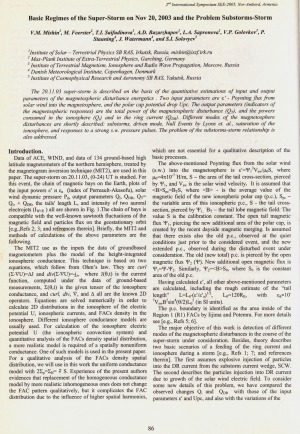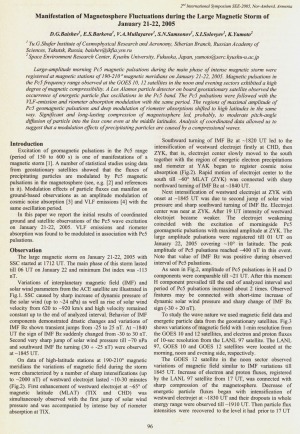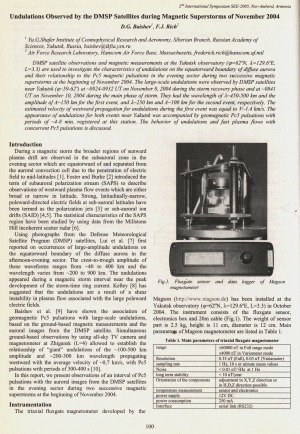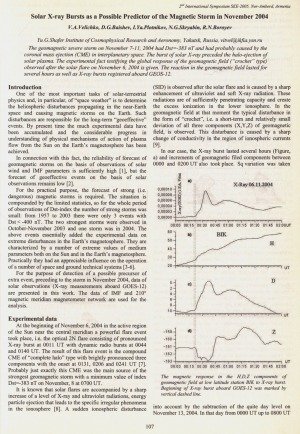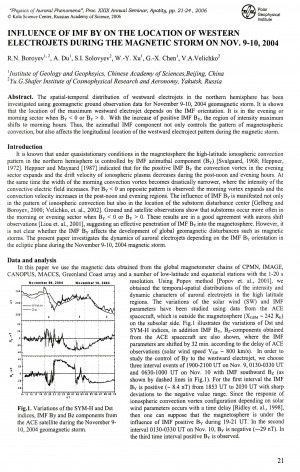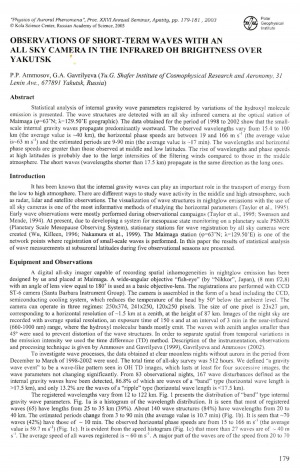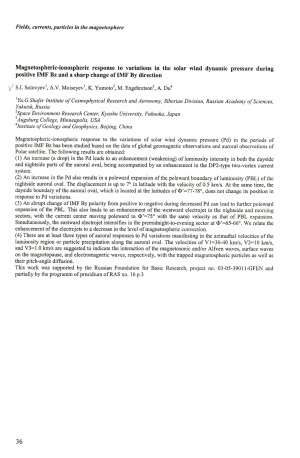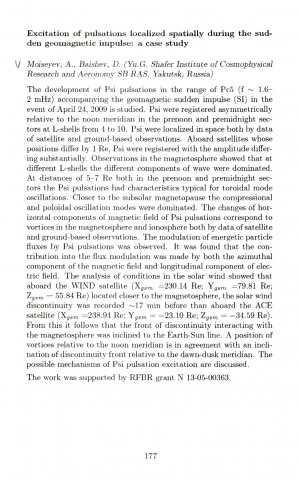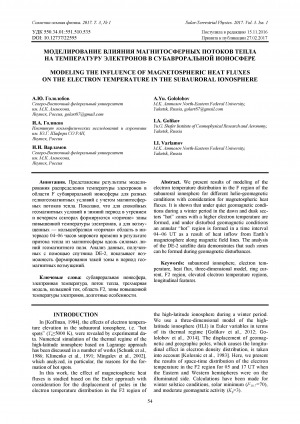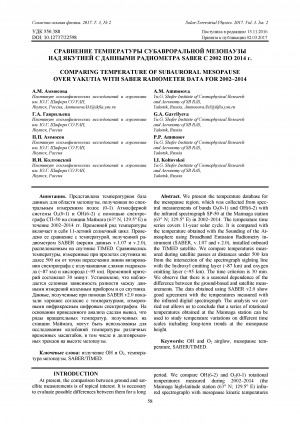Количество страниц: 4 с.
- Математика. Естественные науки > Астрономия. Астрофизика. Исследование космического пространства. Геодезия,
- Математика. Естественные науки > Геология. Геологические и геофизические науки,
- НАУКА ЯКУТИИ > МАТЕМАТИКА. ЕСТЕСТВЕННЫЕ НАУКИ > Астрономия. Астрофизика. Исследование космического пространства. Геодезия,
- НАУКА ЯКУТИИ > МАТЕМАТИКА. ЕСТЕСТВЕННЫЕ НАУКИ > Геология. Геологические и геофизические науки.
Basic Regimes of the Super-Storm on Nov 20, 2003 and the Problems Substorms-Storm / V. M. Mishin, M. Foerster, T. I. Saifudinova, A. D. Bazarzhapov, L. A. Sapronova, V. P. Golovkov, P. Stauning, J. Watermann, and S. I. Solovyev // Solar Extreme Events Fundamental Science and Applied Aspects Nor-Amberd, Armenia 26-30 September 2005 : proceedings of the Second International Symposium / edited by A. Chilingarian and G. Karapetyan. − Erevan : Cosmic Ray Division, Alikhanyan Physics Institute, 2006. − P. 86-89.
Количество страниц: 4 с.
Manifestation of Magnetosphere Fluctuations during the Large Magnetic Storm of January 21-22, 2005 / D. G. Baishev, E. S. Barkova, V. A. Mullayarov, S. N. Samsonov, S. I. Solovyev, K. Yumoto // Solar Extreme Events Fundamental Science and Applied Aspects Nor-Amberd, Armenia 26-30 September 2005 : proceedings of the Second International Symposium / edited by A. Chilingarian and G. Karapetyan. − Erevan : Cosmic Ray Division, Alikhanyan Physics Institute, 2006. − P. 96-99.
Количество страниц: 4 с.
Baishev, D. G. Undulations Observed by the DMSP Satellites during Magnetic Superstorms of November 2004 / D. G. Baishev, F. J. Rich // Solar Extreme Events Fundamental Science and Applied Aspects Nor-Amberd, Armenia 26-30 September 2005 : proceedings of the Second International Symposium / edited by A. Chilingarian and G. Karapetyan. − Erevan : Cosmic Ray Division, Alikhanyan Physics Institute, 2006. − P. 100-103.
Количество страниц: 2 с.
- Математика. Естественные науки > Астрономия. Астрофизика. Исследование космического пространства. Геодезия,
- Математика. Естественные науки > Геология. Геологические и геофизические науки,
- НАУКА ЯКУТИИ > МАТЕМАТИКА. ЕСТЕСТВЕННЫЕ НАУКИ > Астрономия. Астрофизика. Исследование космического пространства. Геодезия,
- НАУКА ЯКУТИИ > МАТЕМАТИКА. ЕСТЕСТВЕННЫЕ НАУКИ > Геология. Геологические и геофизические науки.
Solar X-ray Bursts as a Possible Predictor of the Magnetic Storm in November 2004 / V. A. Velichko, D. G. Baishev, I. Ya. Plotnikov, N. G. Skryabin, R. N. Boroev // Solar Extreme Events Fundamental Science and Applied Aspects Nor-Amberd, Armenia 26-30 September 2005 : proceedings of the Second International Symposium / edited by A. Chilingarian and G. Karapetyan. − Erevan : Cosmic Ray Division, Alikhanyan Physics Institute, 2006. − P. 107-108.
Количество страниц: 4 с.
Influence of IMF by on the location of western electrojets during the magnetic storm on Nov. 9-10, 2004 / R. N. Boroev, A. Du, S. I. Solovyev, W.-Y. Xu, G.-X. Chen, V. A. Velichko // Physics of auroral phenomena : proceedings of the 29th annual seminar, Apatity, 27 February–3 March 2006. – 2007. – P. 21-24.
Количество страниц: 3 с.
Ammosov, P. P. Observations of short-term waves with an all sky camera in the infrared oh brightness over Yakutsk / P. P. Ammosov, G. A. Gavrilyeva // Physics of auroral phenomena : proceedings of the 26th annual seminar, 25 -28 February 2003. – 2003. – P. 179-181.
Количество страниц: 2 с.
Magnetospheric-ionospheric response to variations in the solar wind dynamic pressure during positive IMF Bz and a sharp change of IMF By direction : [тезисы докладов] / S. I. Solovyev, A. V. Moiseyev, K. Yumoto, M. Engebretson, A. Du // Physics of auroral phenomena : 29th annual seminar, 27 February – 3 March 2006 : abstracts. – 2006. – P. 36.
Количество страниц: 1 с.
Moiseyev A. V., Excitation of pulsations localized spatially during the sudden geomagnetic impulse: a case study / Moiseyev A., Baishev D. // 10th International conference "Problems of geocosmos", St. Petersburg, Petrodvorets, October 6-10, 2014. – St. Petersburg : [s. n.], 2014. – P. 177.
Количество страниц: 4 с.
Gololobov, A. Yu. Modeling the influence of magnetospheric heat fluxes on the electron temperature in the subauroral ionosphere = Моделирование влияния магнитосферных потоков тепла на температуру электронов в субавроральной ионосфере / A. Yu. Gololobov, I. A. Golikov, I. I. Varlamov // Солнечно-земная физика = Solar-Terrestrial Physics. – 2017. – Т. 3, N 2 : 13-я российско-китайская конференция по космической погоде. – С. 54-57. – DOI: 10.12737/22595.
DOI: 10.12737/22595
Количество страниц: 6 с.
Comparing temperature of subauroral mesopause over Yakutia with SABER radiometer data for 2002–2014 = Сравнение температуры субавроральной мезопаузы над Якутией с данными радиометра SABER с 2002 по 2014 г. / A. M. Ammosova, G. A. Gavrilyeva, P. P. Ammosov, I. I. Koltovskoi // Солнечно-земная физика = Solar-Terrestrial Physics. – 2017. – Т. 3, N 2 : 13-я российско-китайская конференция по космической погоде. – С. 58-63. – DOI: 10.12737/22598.
DOI: 10.12737/22598
